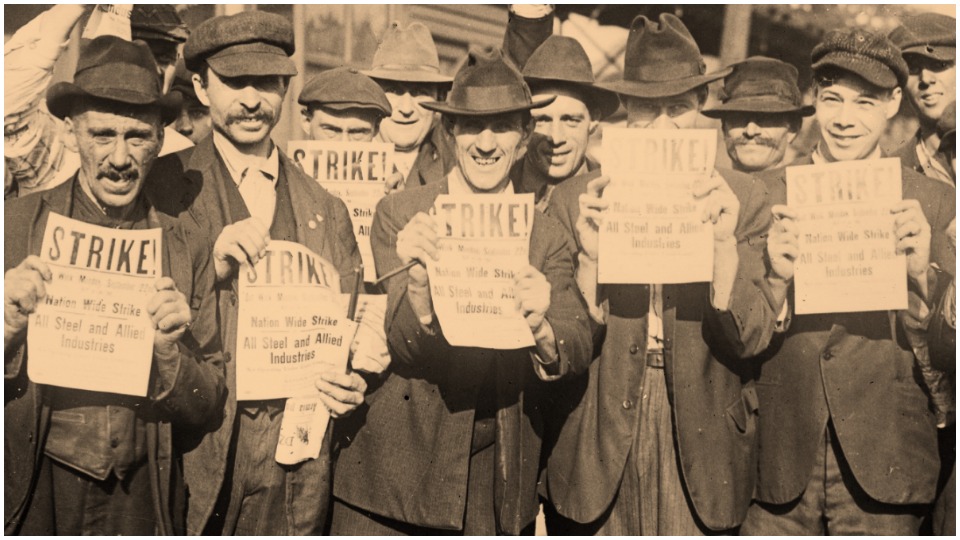
The Communist Party USA was founded in the middle of a year of intense and militant workers struggle. From coast to coast in 1919, and among workers in a wide variety of industries, the U.S. working class stood up for its rights and for the dignity of labor. It was met at every step by the forces of capital, be it through court orders or the armed might of the police and the military. Some workers won victories, but often the forces of repression brought about defeat. The flame of righteous struggle, however, could never be extinguished. This is the first of a 3-part series in which David Cavendish analyzes some of the major strikes of this pivotal year in U.S. labor history.
Throughout history, wars have had profound impact on human society. Not only does territory often change hands, but there are often great changes in political structures and systems, social upheaval, and economic dislocation. World War I is a prime example.
Not only did more than 15 million people die, but the cost of the war, by some estimates, reached more than $300 billion (the equivalent of $4.5 trillion today), and four major empires—the German, Austro-Hungarian, Ottoman, and Russian—disappeared from the face of the earth. It’s the fourth, the Russian, that interests us in this story.
The Russian czarist empire was an authoritarian system that existed for centuries. Ruled by a corrupt nobility, with the Czar at the center, the government exploited the overwhelmingly peasant population. By the twentieth century, the masses had begun to organize themselves into revolutionary organizations dedicated to their liberation from tyranny. Ultimately, the most prominent of these groups were the Bolsheviks, led by Vladimir Lenin. Dedicated to the creation of a new type of state led by an alliance of the peasants and industrial workers, the Bolsheviks began the task of tearing down the capitalist order and replacing it with a socialist one.
The Bolshevik Revolution inspired workers all over the world, while at the same time becoming the worst nightmare for the capitalists and all those who lived by the exploitation of others. This was true nowhere more so than in the United States.
2019 marks a century since the founding of the Communist Party USA. To commemorate the anniversary of the oldest socialist organization in the United States, People’s World has launched the article series: 100 Years of the Communist Party USA. Read the other articles published in the series and check out the guidelines about how to submit your own contribution.
Opposition to U.S. involvement in the conflict existed from the outbreak of hostilities in Europe. When our government entered the war, many worked ceaselessly against U.S. involvement, with the socialist Eugene V. Debs among the most notable. Radical socialists and workers, many of whom were members of the Industrial Workers of the World (IWW), faced serious penalties for their actions, including imprisonment and deportation.
The IWW had been founded in 1905 as a revolutionary alternative to the conservative “bread-and-butter” unionism of the American Federation of Labor (AFL). Its members were known as “Wobblies,” and were led by prominent labor radicals William D. “Big Bill” Haywood (who would later become a member of the Communist Party USA), Debs, as well as Lucy Parsons (wife of Haymarket martyr Albert Parsons), and “Mother” Mary Harris Jones.
The IWW based its program on building “One Big Union,” that is, a revolutionary movement based on industrial unionism with the goal of overthrowing the capitalist system. It would gain its greatest strength during the World War I era and its strongest support among workers neglected by the craft-based AFL—miners, textile workers, meat packers, and timber workers, among others.
Its militancy brought about a response that showed the coercive power of the capitalist state. Several “free speech” campaigns, designed to express workers’ First Amendment rights were initiated by the IWW. These actions led to the imprisonment of many of its supporters, among them Elizabeth Gurley Flynn, the “Rebel Girl,” another later leader of the Communist Party.
Other radical tendencies also grew in the early decades of the twentieth century. Foremost was the Socialist Party, founded in 1901. It gained support among trade unionists, populists, and immigrants. The party used electoral politics as a way to advance its program, and by 1912 it had achieved a measure of success. The party elected over a thousand officials, mostly at the local level, across the country. Debs, its candidate for president, received over 900,000 votes in his best showing, 6% of the total.
By the outbreak of World War I, both the IWW and the Socialist Party had gained positions in the U.S. not since equaled by any other radical organization. The Bolshevik Revolution added a new dimension to this equation.

As a way to counter the influence of the radical left and build support for the war among working people, President Woodrow Wilson created the National War Labor Board. It issued rulings and regulation that improved the lives of those at work, in many cases breaking new ground in protecting workers’ rights. In exchange for a pledge not to strike, unions were given recognition. The eight-hour day was instituted on war contract work, wages rose, and the 48-hour week became widespread. Union membership burgeoned, reaching four million in 1920.
The Armistice in 1918 led to a heightening of the class struggle, however. The closing of the War Labor Board added to growing economic pressures on the working class. Inflation worsened as food prices doubled and clothing prices tripled between 1915 and 1920. Many veterans were unable to find work. Employers, ever fearful of diminished profits and the growth of “Bolshevism,” decided to act. The workers, facing economic turmoil, did what they could to protect their livelihoods. The result was a period of intense labor militancy that ran up against the power of the capitalists and the U.S. government.
The year of greatest labor militancy was 1919, though struggles continued into the next decade. In that year, more than four million workers, one out of every five in the workforce, went on strike. Among them were more than 350,000 steelworkers, 400,000 miners, as well as millions more in other sectors of the economy. These included Broadway actors and other theater workers; dress and waist makers in New York City, and elsewhere; the Boston police; and a general strike in Seattle.
In this, the centennial year of these events, we need to look back and celebrate the militancy of American workers.












Comments